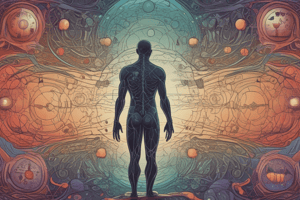Podcast
Questions and Answers
What is homeostasis?
What is homeostasis?
The process of maintaining a stable internal environment in the body.
Why is homeostasis important?
Why is homeostasis important?
It keeps the body healthy and free from disease.
What conditions are maintained in the human body to achieve homeostasis?
What conditions are maintained in the human body to achieve homeostasis?
Body fluid volumes, blood pressure, body fluid composition, body fluid pH, blood gases, blood glucose, body temperature.
What are the components of a feedback mechanism?
What are the components of a feedback mechanism?
Which of the following is an example of a negative feedback mechanism?
Which of the following is an example of a negative feedback mechanism?
Which type of body fluid is found inside cells?
Which type of body fluid is found inside cells?
Blood pressure is independent of body fluid volume.
Blood pressure is independent of body fluid volume.
What is the normal pH range of body fluids?
What is the normal pH range of body fluids?
What are the primary components of the cell membrane?
What are the primary components of the cell membrane?
What role does the glycocalyx play in the immune system?
What role does the glycocalyx play in the immune system?
What is the resting membrane potential (RMP)?
What is the resting membrane potential (RMP)?
The total body water (TBW) is __%.
The total body water (TBW) is __%.
Action potentials represent how muscles and neurons communicate.
Action potentials represent how muscles and neurons communicate.
Flashcards are hidden until you start studying
Study Notes
Homeostasis
- Homeostasis involves maintaining stable internal conditions within the human body despite external changes.
- It is crucial for good health, preventing disease by keeping various variables within narrow limits.
- Seven key conditions (variables) are monitored for homeostasis: body fluid volumes, blood pressure, body fluid composition, body fluid pH, blood gases, blood glucose, and body temperature.
Body Fluid Volumes
- Total Body Water (TBW) is approximately 60%, with 40% being intracellular fluid and 20% extracellular fluid.
- The cell membrane is critical in separating and regulating these fluid compartments.
Blood Pressure
- Blood pressure (BP) is influenced by body fluid volume and composition; low fluid volume leads to decreased BP.
Body Fluid Composition
- Composed of essential ions (potassium, sodium, chloride, calcium) and small molecules.
- Ions and water migrate across cell membranes via transport mechanisms like diffusion, osmosis, and active transport.
Body Fluid pH
- The normal pH range is between 7.37 and 7.43, optimal for cellular enzyme activity and membrane integrity.
Blood Gases
- Homeostasis includes the regulation of blood gases, primarily carbon dioxide and oxygen.
Blood Glucose
- Stable blood glucose levels are vital for cellular metabolism and energy production.
Body Temperature
- Maintaining a stable body temperature is essential for enzymatic reactions and overall metabolic functions.
Cell Membrane Structure
- Composed of a phospholipid bilayer and proteins, the cell membrane functions as a selective barrier.
- The fluid mosaic model describes the arrangement where hydrophilic heads face outward and hydrophobic tails face inward.
Transport Mechanisms
- Lipid-soluble substances (e.g., oxygen, carbon dioxide) can easily cross the membrane, while water-soluble substances (e.g., sodium, glucose) require channels or carriers.
- Types of transport include:
- Diffusion: Movement of molecules from high to low concentration.
- Osmosis: Diffusion of water across a semipermeable membrane.
- Facilitated Diffusion: Passive transport through channel proteins.
- Active Transport: Energy-dependent movement against a concentration gradient.
- Bulk Transport: Movement of large substances via vesicles.
Resting Membrane Potential (RMP) and Action Potential
- RMP is established by the normal ion composition and is critical for neuronal and muscular communication.
- Action potentials are electrical signals transmitted by neurons and muscle cells, enabling communication and function.
Role of Organ Systems
- Various organ systems work collaboratively to sustain homeostatic conditions, each contributing to the overall balance of the body's internal environment.
Monitoring Vital Signs
- Regular monitoring of vital signs is essential for assessing homeostasis and detecting potential health issues early, ensuring timely intervention and treatment.
Studying That Suits You
Use AI to generate personalized quizzes and flashcards to suit your learning preferences.




